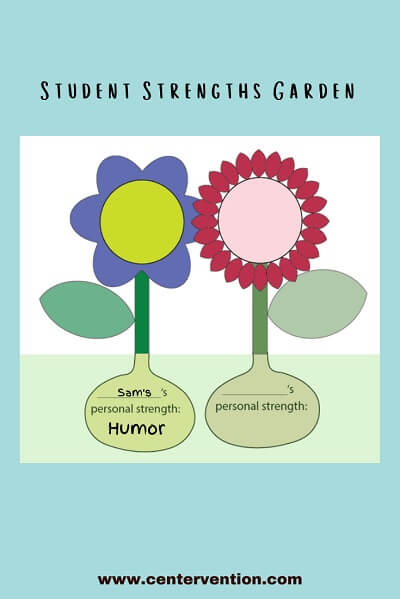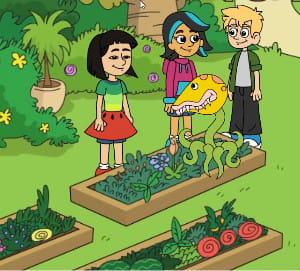In this lesson, students will create a student strengths flower that highlights their positive traits, and this flower will be added to a student strengths garden that showcases the collective abilities for the entire class.
By creating a student strengths flower, students will:
- Reflect on their individual strengths
- Think about a time when they used a strength
- Consider what positive consequences occurred when they used that strength
And by adding their flower to a “community garden,” students will appreciate how individual characteristics contribute to the greater classroom community.

Recommended Grade Level: All
SEL Skill(s): Self-awareness, Empathy
Duration: 30 minutes
Materials:
- Student strengths worksheets: Black-and-white worksheet OR pre-colored
- Pens/pencils (for in-person lesson)
- Crayons or markers (for in-person lesson)
- Sticky notes (for in-person lesson)
- Virtual option: Google Slides version
Directions for Student Strengths Lesson
Preparation
If you will be using this lesson in person, you should print out a sheet for each student and provide a pen or pencil. There is a black-and-white version of the worksheet if you would like to have students also color in the flower or you can use the pre-colored version of the worksheet. Note: you will only need to provide one flower page per student.
If you want to use the Google Slides version of this lesson, duplicate the flower slides so there are enough for each student and you should fill in one flower to use as an example. Share a link to the slides with your students.
Introducing the activity
Tell your students, “Each of us has different strengths: things that we’re really good at, and our personal strengths can make things better for the people around us. And here in our classroom, every one of you have strengths that make the classroom a better place. Today we’re going to think about our strengths and write them down on a flower.”
Show an example flower
“We’re going to be making a Student Strengths Garden together. Just like a flower can grow from a bulb you plant in the ground, good things can come from your strengths and how you use them. For example,
- I’m good at [cheering people up],” Show where you wrote this in the bulb.
- “A time that I used this strength was when I [made silly faces for my sister when she was sick].” Show where you wrote this in the leaf.
- “When I used my strength, [she laughed and felt better].” Show where you wrote this in the leaf.
Here are a few additional ideas for strengths: good friend, good listener, has a positive attitude, helpful, tries hard when learning new things, polite, listens to directions, respects other people and their ideas, good at following routines, etc.
Creating a student strengths flower
“Now each of you will make a flower showing one of your strengths.”
Ask students to choose a flower worksheet or pass them out, and if students will be coloring in their worksheets, distribute markers or crayons.
Ask students to fill out the worksheet by starting at the base of their flower and working up toward the top. Have students write:
- Their name
- A strength of their own
- A time they used that strength
- What happened when they used that strength
Combining individual flowers to create a classroom garden
First, have students place their flowers on a wall to create a “classroom garden.” If you are using Google Slides, the individual flowers should already be included. Next, as a group, have student take a “walk” around the garden and look at the individual flowers. After a few minutes, have students return to their seats. Finally, ask students to share what they learned about their classmates strengths.
To wrap up, we encourage you to discuss how all of these individual differences create a much stronger group.
Lesson Extension From Zoo Academy
If you’re using Centervention’s Zoo Academy with your students, the lesson above lines up well with scene seven.
In scene seven, Mr. Greene helps players and other students explore a garden, where unique flowers look like animals and people. Players will look at the different flowers’ facial expressions and body language and identify which emotions they portray. Players will also hear and view an animated song showing the physical symptoms that come with different emotions, like a flipping stomach for feeling scared or a hot face when angry.

